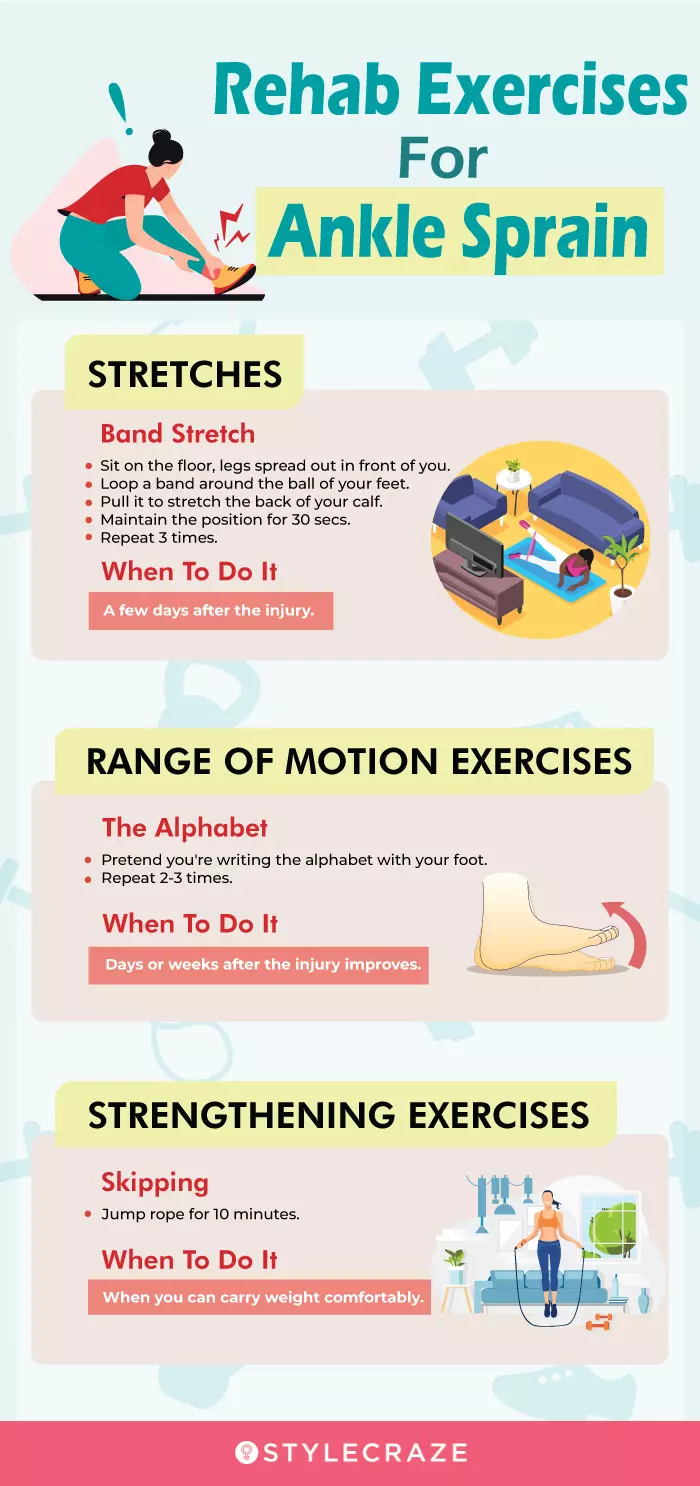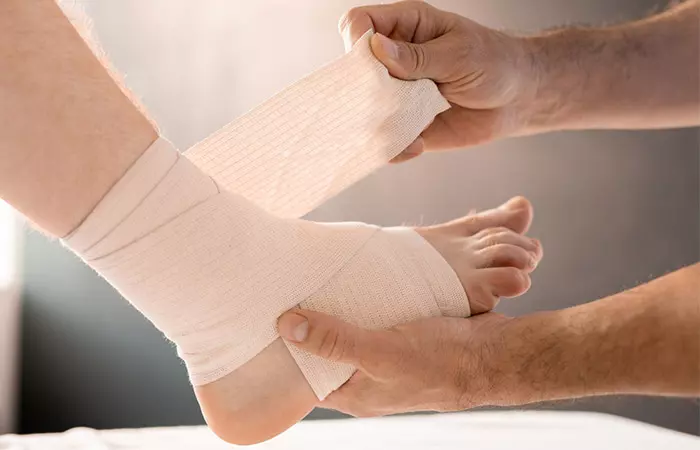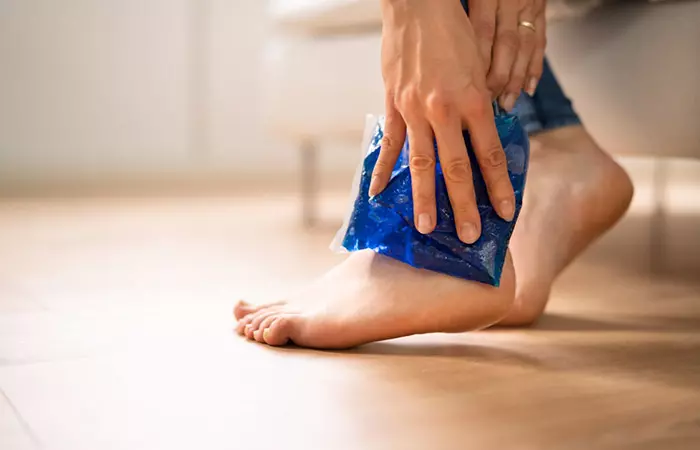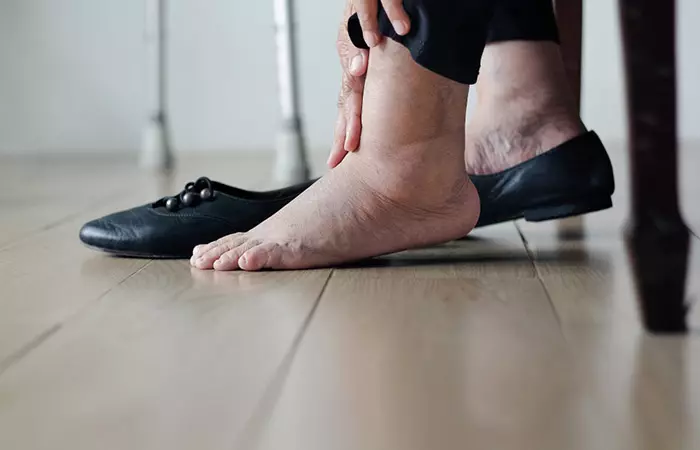Home Remedies To Heal A Sprained Ankle Overnight
Getting relief from a sprained ankle isn't as complex as you would have thought.

Image: Shutterstock
If you are a fitness enthusiast or a sportsperson, there is nothing worse than spraining your ankle. But, sometimes, you may sprain your ankle even when you are not doing any intense activity. This may happen while wearing high heels or by tripping or landing on your foot wrong. If you are wondering how to heal a sprained ankle overnight, you are in the right place. Keep reading this article to find out!
In This Article
What Is A Sprained Ankle?
A sprained ankle is a short-term physical injury that occurs when the ligaments and fibers that hold your ankle are stretched beyond their regular capacity. It may be caused by weak ankle ligaments, tendons, and calf muscles or due to your ankle rolling in or out of position or landing awkwardly on your feet while walking, running, or jumping. An injury caused by an inward roll is called an eversion sprain, whereas an outward roll is called an inversion sprain.
Leah, a former gymnast in a youtube video shares her personal experience when she had an ankle injury, sprain and her recovery. She says ” “I was able to start physical therapy 3 weeks post-op as opposed to 6 or 8 weeks with the previous surgeries.”Eight weeks after surgery with InternalBrace ligament augmentation, “I have zero pain, zero instability, and it feels great…I’m looking forward to trying new things now…I feel like I have a new ankle! (i).
Depending on how you have twisted your ankle, the sprain can be categorized either as a low-grade injury or a high-grade injury. Low-grade injuries result in microscopic tears of the supporting ligaments, whereas high-grade injuries may cause major tears in the ligaments and tendons. In some cases, it may also cause fractures in the ankle (1).
A review of 909 new patients found the overall prevalence to be at 49.% for men and 50% for women. Of these 909 patients, 29% got the sprain from tripping, 26.4% had a non-specific injury, 26% from sports (with football being the most prevalent at 13%), 12.2% from walking, and 6% from other accidents.
Severe ankle sprains can be painful and quite inconvenient, particularly if you have an active lifestyle or are a professional athlete. But, with proper care and treatment, you may be able to prevent it from getting worse.
We discussed what a sprained ankle is. Let’s find out some of its common symptoms in the next section.
Sprained Ankle Symptoms
The symptoms of a sprained ankle greatly vary widely depending on the intensity of the injury. The symptoms may include (2):
- Pain
- Bruising
- Tenderness to the touch
- Swelling
- Inability to put weight on the affected ankle
- Stiffness
- Difficulty in walking
- Skin discoloration
- Popping sensation
- Instability of the ankle
These symptoms may manifest across different types of ankle sprains. Let’s discuss them below.
Types Of Ankle Sprains
There are different types of ankle sprains. They are categorized according to the severity of the injury and its exact location. The three main types of ankle sprains are (3):
- Grade 1 (mild) ankle sprain: The ligament fibers stretch slightly, with a little swelling and tenderness to touch.
- Grade 2 (moderate) ankle sprain: It involves partial tearing of the ligament with moderate swelling and pain.
- Grade 3 (severe) ankle sprain: It involves a complete rupture of the ligament with severe pain and bruising.
If you are wondering how long a sprained ankle takes to heal or what to do for a sprained ankle, check out the remedies in the next section.
How To Heal A Sprained Ankle Overnight
Any injury takes time to heal. You cannot miraculously heal a sprained ankle overnight. Patience, proper care, and sufficiently resting your sprained ankle are key for your recovery. If you really want to speed up the recovery process, here are a few home remedies you can try.
1. The PRICE Or RICE Method
A tried and tested method of treating an ankle sprain is the PRICE or RICE method. PRICE stands for Protection, Rest, Ice, Compression, and Elevation. If you remove protection from PRICE, you get RICE.
When you sprain your ankle, ample rest is required in the first 72 hours. You can support and protect your ankle either by wrapping it with an elastic bandage or wearing an ankle brace. This will help keep your ankle compressed.
How To Wrap A Sprained Ankle
- Take a 6-inch ACE bandage.
- Wrap it once around the base of your toes. Make sure it feels snug and tight, but not so tight that it cuts off the blood supply.
- Slowly begin to wrap it towards your ankle in a figure-8 motion.
- Repeat this till your ankle feels well-supported and snug.
- Secure the remaining bandage with the clips provided or with a safety pin.
Note: Using Kinesiotape or KT tape underneath the bandage can provide additional support to the ankle as well as the ligaments.
Keep your ankle in an elevated position for as long as you can to reduce some of the swelling caused by the injury (1).
The PRICE/RICE method is the most widely used treatment for ankle sprains, but it takes time to fully heal a sprained ankle.
 Quick Tip
Quick Tip2. Use An Ice Pack Or Hot Pack
Applying an ice pack to the sprained ankle helps in reducing the temperature of the injured tissues and slows down muscle metabolism. This may help in reducing pain, swelling, minimizing muscle spasms, and promoting recovery (4). For cold therapy, you can use ice cubes wrapped in a towel. You can also dip a towel in ice-cold water and gently massage the injured area or place it on the injured area. If you are not able to apply ice to the area, peppermint, menthol, or camphor essential oils applied topically may also reduce swelling.
Applying heat to the injured area may help relieve stress, tension, and stiffness in the muscle. It has also been found to be effective in reducing pain and muscle spasms (4). You can use a hot water bottle or dip a towel in hot water and place it on the injured area or gently massage it. However, although heat packs may feel good, do not apply heat in the first 48 hours of injury as the area is already inflamed.
Hot and cold therapies are widely used to treat musculoskeletal injuries (injuries that affect the bones and muscles). Based on your preference, you can choose from either of the two practices or use them together for maximum benefit. To use them together, do 20 minutes of heat and 20 minutes of cold, then alternate.
 Quick Tip
Quick Tip3. Take A Painkiller Or Anti-inflammatory Medication
Nonsteroidal anti-inflammatory drugs (NSAIDs) such as diclofenac, ibuprofen, and naproxen are a few of the OTC medicines that are commonly used to relieve pain (5). Apart from these NSAID tablets, you could also use pain relief sprays, ointments, and gels on the sprained ankle.
The use of CBD has been shown to help decrease inflammation when used topically. It may also be used orally for pain relief, if a person is looking for a natural option.
But before you start popping painkillers or using natural medicines, it’s better to consult your doctor as some of them may cause gastrointestinal or cardiovascular problems (5).
4. Try Some Mild Exercise
Exercising immediately after spraining your ankle is a no-brainer. However, after a couple of days of rest, mild ankle exercises or physical therapy might help in quickening your recovery. Limited evidence suggests that performing eccentric exercises may provide better short-term relief compared to wearing a brace (6).
Exercising after an injury is subject to the degree of severity of that injury. You can start putting weight on your sprained ankle if your sprain is mild (overstretched ligaments). If it is a severe ankle sprain (torn ligaments), your mobility may be affected for at least 5-6 weeks (7). Be conservative with your movements, and take it easy. It is recommended to typically take twice the time you think you may need to ensure you do not re-injure the area.
Nursing your sprained ankle and ensuring the injury does not get worse is important for a quick recovery. However, if you accidentally worsen your injury, what could happen? Read the next section to find out.
Risks And Complications
A study conducted at the University of California (USA) suggests that in the USA, nearly 10-30% of patients with an ankle sprain can develop chronic ankle instability. This can cause mechanical or functional instability to your ankle. Mechanical instability can result in ligamentous laxity, which causes your joints to bend more than usual. It may also cause impaired arthrokinematics (movement of joint surfaces), which may affect how your joints move and cause serious discomfort (8).
Functional instability can cause serious nerve damage and result in a condition called impaired proprioception (8). This condition makes you feel like your ankle does not exist, i.e., it deprives you of feeling any sort of sensation in your ankle.
So, it is important to take care of your sprained ankle and not rush the recovery process to avoid such complications. But, how do you know if your ankle sprain is much more than a sprain and that you require medical assistance? Find out in the next section.
When Should You See A Doctor?
Ankle sprains are always worrisome as they are internal injuries. By simply looking at them, it is not possible to determine the severity of the situation. You should seek medical attention if any of the following is applicable to your injury.
- If your ankle is abnormally swollen, and the swelling is not subsiding with OTC medication.
- You are unable to put the slightest weight on your ankle.
- If you notice bruising on the ankle and its surrounding areas.
- If the pain does not reduce despite taking painkillers for several days after the injury.
- If your ankle continues to feel weak even after physiotherapy.
Infographic: Rehab Exercises For Ankle Sprain
Ankle sprains prompt swelling and discomfort and reduce the range of motion. They occur when the ankle rolls, bends, or rotates in an odd manner.
Many individuals manage a sprained ankle at home by resting, applying ice, and taking pain relief medicines. However, you can speed up this recovery process by incorporating a few rehab exercises into your lifestyle. Check out the infographic below to learn more! Illustration: StyleCraze Design Team
While the above tips and tricks can help heal a sprained ankle faster, you must take care to prevent any strain or accident in the first place itself. Avoiding high heel shoes, reducing weight, wearing terrain-appropriate shoes, can all help reduce the chances of an accidental ankle sprain. First aid, rest, and proper support are important to treat an ankle sprain. Hot and cold compress, RICE method, anti-inflammatory medications or natural agents, along with a bit of mild exercise can help reduce pain and aid faster recovery.
Frequently Asked Questions
Can I walk on my sprained ankle after 3 days?
It depends on the sprain’s grade. Typically, a grade 1 sprain causes minor damage to the ligament, and you can walk on it after 2-3 days. However, grade 2 and 3 sprains may take 4-8 weeks of recovery and rehabilitation as they involve tissue tears, bruising, and swelling.
Do I need an x-ray for a sprained ankle?
Depending on the severity of pain and the affected area, your healthcare provider may or may not recommend an X-ray to understand the depth of the injury. If your doctor suspects a bone injury or fracture, you might have to get an X-ray.
How do you sleep with a sprained ankle?
Wrap a compression bandage or an ice pack around your ankle and elevate it by placing pillows under your foot. This will help you get enough rest and ease the swelling and pain around your sprained ankle.
Is MRI better or a CT scan for an ankle sprain?
MRIs are preferred over CT scans because they offer precise information about the surrounding ligaments and tendons. A CT scan is called for when your doctor suspects multiple bone fractures.
Should I wear shoes with a sprained ankle?
Yes. Specific shoes that are comfortable and provide suitable arch support may be worn however, flip-flops and high heels are to be avoided.
How long is bed rest necessary for a sprained ankle?
Depending on the severity of the sprain, anywhere from a couple of hours to several days might be necessary to heal your sprained ankle. Consult your healthcare provider to determine the bed rest period.
Key Takeaways
- When the fibers and ligaments holding your ankle are stretched more than their appropriate capacity, the ankle is sprained.
- It is not advisable to walk when your ankle is sprained.
- Use an ice pack or hot pack, or try the PRICE or RICE method to heal a sprained ankle overnight.
Curious about sprained ankle recovery time? Then, check out this insightful video below to gain valuable insights into the healing process, expected timelines, and tips for a speedy recovery.
Personal Experience: Source
StyleCraze's articles are interwoven with authentic personal narratives that provide depth and resonance to our content. Below are the sources of the personal accounts referenced in this article.
i. Serious Ankle Injury | Avid Runner & Skier | Leah’s Storyhttps://www.youtube.com/watch?v=KS74ZWyhbBE
References
Articles on StyleCraze are backed by verified information from peer-reviewed and academic research papers, reputed organizations, research institutions, and medical associations to ensure accuracy and relevance. Read our editorial policy to learn more.
- Acute Ankle Sprain
https://www.ncbi.nlm.nih.gov/books/NBK459212/ - Ankle sprain
https://www.ncbi.nlm.nih.gov/pmc/articles/PMC2907605/ - Exercise for the Treatment of Ankle Sprain: A Review of Clinical Effectiveness and Guidelines
https://pubmed.ncbi.nlm.nih.gov/33074633/ - Role Of Cold Therapy And Hot Therapy In Sports Injuries Sports Injuries
https://www.researchgate.net/publication/346075542_Role_of_Cold_Therapy_and_Hot_Therapy_in_Sports_Injuries_SPORTS_INJURIES - Nonsteroidal Anti-Inflammatory Drugs In Chronic Pain: Implications Of New Data For Clinical Practice
https://www.ncbi.nlm.nih.gov/labs/pmc/articles/PMC6160277/ - The Effectiveness Of Exercise On Recovery And Clinical Outcomes Of Soft Tissue Injuries Of The Leg Ankle And Foot: A Systematic Review By The Ontario Protocol For Traffic Injury Management (OPTIMa) Collaboration
https://pubmed.ncbi.nlm.nih.gov/25892707/ - What Are The Treatment Options For Ankle Sprains?
https://www.ncbi.nlm.nih.gov/books/NBK279550/ - Lateral Ankle Sprain and Chronic Ankle Instability
https://journals.sagepub.com/doi/full/10.1177/2473011419846938 - Effect of Chronic Ankle Sprain on Pain Range of Motion Proprioception and Balance Among Athletes
https://www.ncbi.nlm.nih.gov/labs/pmc/articles/PMC7432694/
Read full bio of Dr. Erica Steele
Read full bio of Ravi Teja Tadimalla
Read full bio of Dipti Sharma






























